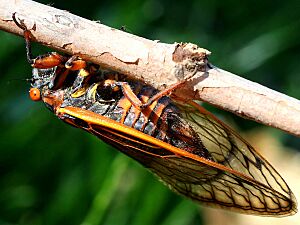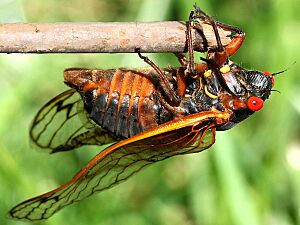Magicicada septendecim facts for kids
Quick facts for kids Magicicada septendecim |
|
|---|---|
 |
|
| Female | |
 |
|
| Male | |
| Conservation status | |
| Scientific classification | |
| Genus: |
Magicicada
|
| Species: |
septendecim
|
Magicicada septendecim, sometimes called the Pharaoh cicada or the 17-year locust, is a special insect found in Canada and the United States. It is the largest type of periodical cicada that lives for 17 years.
Contents
What is a Pharaoh Cicada?
Like other Magicicada species, the Pharaoh cicada has reddish eyes and wing veins. Its back is black. You can tell it apart by the wide orange stripes under its belly and orange spots on the sides of its body.
When these cicadas want to find a mate, the males make a loud, high-pitched song. People say it sounds like "weeeee-whoa" or "Pharaoh." This sound is similar to a 13-year cicada species called Magicicada neotredecim.
Because M. septendecim is very similar to two other 13-year cicada species, M. neotredecim and M. tredecim, these three are often grouped together. They are known as "decim periodical cicadas."
Life Cycle of the Pharaoh Cicada
The Pharaoh cicada's life cycle, from egg to natural adult death, usually lasts about seventeen years. However, their life cycle can sometimes be shorter, around thirteen years, or longer, up to twenty-one years.
Discovering the Cicada's Secret
People have been writing about huge numbers of noisy cicadas appearing every 15 to 17 years since as early as 1733. John Bartram, a famous botanist and gardener from Philadelphia, was one of the first to describe the insect's life cycle and how it looked.
In 1749, a Finnish naturalist named Pehr Kalm visited Pennsylvania and New Jersey. He saw a large group of these cicadas appear. He later wrote that people believed these insects showed up in huge numbers every seventeen years. He also mentioned that they stayed underground most of the time.
Kalm also learned from Benjamin Franklin that many cicadas had appeared in Philadelphia in May 1732. Kalm's own observations in 1749 and 1750, along with these older reports, helped confirm that the cicadas truly appeared every seventeen years.
In 1758, based on Kalm's information and a cicada sample he provided, Carl Linnaeus officially named the insect Cicada septendecim. The word "septendecim" means seventeen in Latin.
Later, in 1775, Thomas Jefferson wrote in his "Garden Book" about the 17-year cycle of these cicadas. He noted that they had appeared at his home in Monticello in 1775, and he remembered other "great locust years" in 1724, 1741, and 1758. He also observed that the female cicadas lay their eggs in the small branches of trees.
In 1800, Benjamin Banneker, a scientist who lived in Maryland, wrote in his record book about the cicadas. He remembered large groups appearing in 1749, 1766, and 1783. He correctly predicted that they would appear again in 1800, seventeen years after their last big emergence.
Images for kids









